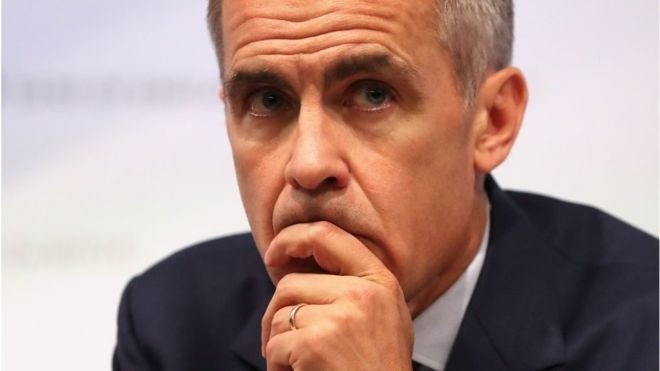A no deal Brexit could send the pound plunging and trigger a worse recession than the financial crisis, the Bank of England has warned.
It said the UK economy could shrink by 8% in the immediate aftermath if there was no transition period, while house prices could fall by almost a third.
The Bank of England also warned the pound could fall by a quarter.
The Bank’s analysis comes after the Treasury said the UK would be worse offunder any form of Brexit.
This Bank’s scenario is not what it expects to happen, but represents a worst-case scenario, based on a so called “disorderly Brexit”.
The scenario looks at the five-year period after the UK leaves the EU.
But by the end of 2023, the economy is expected to resume growing.
“These are scenarios not forecasts. They illustrate what could happen not necessarily what is most likely to happen.
“Taken together the scenarios highlight that the impact of Brexit will depend on the direction, magnitude and speed of the effect of reduced openness of the UK economy,” Bank of England governor Mark Carney said.
What is a ‘disorderly Brexit’?
The Bank of England has made a number of assumptions – not forecasts – about what would cause a disorderly Brexit.
- The UK reverts to World Trade Organization rules
- No new trade deals are implemented by 2022
- The UK loses all access to existing trade agreements between the EU and third countries
- Severe disruption at borders because of customs checks
- Migration reverses from 150,000 a year to falling by 100,000 a year
The Bank of England does not give a probability of this happening.
What happens during this disorderly scenario?
Scenarios drawn up the Bank of England show that GDP would fall by 8% in 2019 against its current forecast.
Growth would quickly resume and the economy would expand again by the end of 2023 but be smaller than where it was before.
Unemployment would rise to 7.5%, house prices fall by 30% and commercial property prices collapse by 48%.
Interest rates would reach 4%.
What other scenarios did the Bank of England consider?
The Bank looked at three other scenarios.
- a “disruptive” Brexit – one where the UK retained access to some trade agreements.
- what might happen if trading arrangements were agreed to give the UK a “close” relationship
- what might happen if trading arrangements were agreed to give the UK a “less close” relationship
A close relationship is one with no customs checks, no regulatory barriers and a partial deal agreed on financial services.
A less close relationship is one where customs checks start after 2021 and other regulatory checks put in place.
What happens in these scenarios?
If Brexit is disruptive rather than disorderly, GDP falls 3% over the five years to 2022, house prices slide 14%, and unemployment reaches 5.75%
If a close trading relationship is agreed, the economy could still be 1% smaller than if the UK had remained in the EU but 1.5% higher than the bank’s most recent estimate.
If it is less close, the economy’s growth could be 3.75% less than if the UK had remained in the EU and 0.75% than forecast over the last inflation report.
These figures cover the period to 2023.
Why is the Bank publishing these figures?
The disruptive and disorderly Brexit scenarios are contained in its half-yearly review of financial stability.
The close and less close scenarios are being published after request by the Treasury Committee of MPs for the impact of Brexit on the Bank’s ability to conduct its remit to maintain financial stability and contain inflation at 2%.
What would happen without a transition deal?
Mr Carney said that surveys showed that less than half of businesses have initiated contingency plans for a no-deal scenario and less than a fifth of small businesses.
“A sober objective assessment of the appropriate length of the implementation period is desirable to get Brexit off to the right start.
“This implementation period should be as long as necessary to prepare properly for the new trading relationships, but no longer”.
What else did the Bank say?
Mr Carney said the Bank was monitoring markets and indicated that the it was ready to lend to banks in the financial markets.
He also indicated that banks might be allowed to hold less capital if risks became too great.
But he warned there was little the Bank could do
But he said the European Commission needed to provide more legal certainty for the derivatives markets.
Banks may have to start rearranging their complex derivatives deals as soon as next month.
The UK also needs to pass legislation for the financial services sector ahead of Brexit, Mr Carney said.
What does it mean for the banking sector?
The Bank of England has exposed seven major lenders to a stress test which it said was two and half times more severe than the Brexit scenarios.
All seven lenders- Royal Bank of Scotland, HSBC, Barclays, Lloyds, Standard Chartered, Santander and Nationwide Building Society – passed the test.
The Bank said: “The UK banking system is strong enough to continue to serve UK households and businesses in the event of a disorderly Brexit.”














